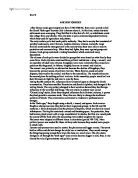The Middle Ages and The Greek Influence
The Middle Ages is also known as the Dark Ages. Medieval artwork was somewhat primitive and backwards, due to the religious influences of the time. The church felt that art should be used as a tool to teach people about the gospel of the Lord and should not be created for one’s own personal enjoyment. The church favored paintings and colorful mosaics over the use of sculptural art to relay the word of God. Trends in artwork began to change as the Romanesque era was ending and the Gothic era was beginning. As the Gothic age began, the artists looked further back in history, to the time of the ancient Greeks, for inspiration.
The Greeks studied the human form and replicated every curve. Clothing was depicted as it lay in natural folds, hanging off the body. The physical structure and facial features were carved in idealistic styles. Natural beauty was embraced and the figures inhabited a real space. Human depictions of the Romanesque era were a far cry from the Classical Greek style. Facial features exhibited cartoon-like expressions and the natural world was not represented in a realistic sense. Symbolism dominated the arts as the main theme of the time. The influence of the revival of interest in Greek history greatly contributed to the spirit of the Gothic era. The focus of the time was evolving and changing to reflect this influence, however, the church remained powerful, and religion continued to exert an extraordinary power over the thoughts and actions of individuals. Eventually, the skills of artists and sculptors became a performance of God-given talent that transcended personal glorification to offer his or her fellow Christians a prospect of the higher world.







